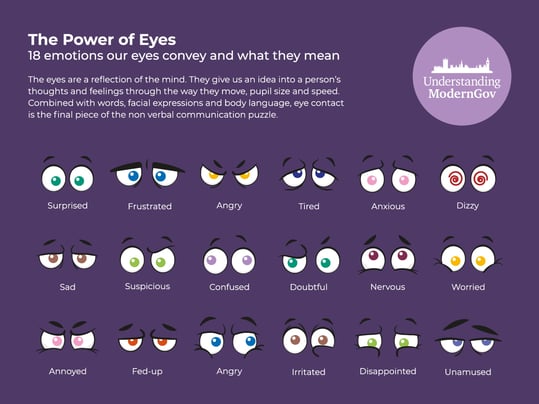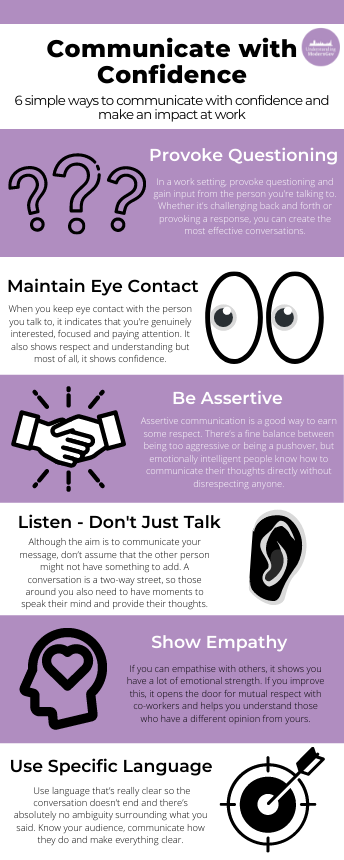13 Steps for Communicating with Confidence
 Chloe Martin
·
5 minute read
Chloe Martin
·
5 minute read
(Updated April 2024)
Whether it’s in life or in the workplace, effective communication is everything.
At some point or another, you’ll deal with big egos, hot-headed figures and people lacking the self-confidence to speak up.
Not knowing how to communicate with different types of people can cause problems both at work and in your personal life.
Being able to communicate with confidence no matter who you are speaking to is the key to long term success. Not to worry. We've got you covered with 13 ways to communicate with confidence in the workplace.
13 Steps for Communicating with Confidence
- Communicate Clearly
- Use Specific Language
- Provoke Questioning
- Use Emotional Intelligence
- Respond to Conflict
- Show Some Assertiveness
- Show Empathy
- Practice Self-Awareness
- Maintain a Positive Attitude
- Body Language and Mannerisms
- Be Approachable
- Maintain Eye Contact
- Listen - Don't Just Talk
1. Communicate Clearly
A lot of the time, it’s thought that confident communication depends on what you say or the words you use. But, it actually depends on what the other person hears which is why communicating clearly is vital.
Clear communication includes:
- Maintaining eye contact and smiling while you’re speaking.
- Speaking at a steady pace so the other person understands what you’re saying.
- Taking a few risks like showing some humour. Like confidence, it’s infectious so spread it as much as you can. This can help conversations go more smoothly.
- Not using ‘maybe’ words like ‘just’, ‘perhaps’ or ‘like’ as it can undersell what you’re trying to say.
It is important to note that the type of communication channel you use to communicate will also affect how your message is received. A study found that 76.2% of workers have misinterpreted an email or instant message while at work.
It is easy for written messages to be misinterpreted over text or email as the tone or intent behind the message cannot be accurately conveyed. Therefore, it is essential that you are mindful of the language you use and ensure it is clear and concise.
2. Use Specific Language
This is where you need to know your audience before communicating with them. The terms and phrases you use might not be in their vocabulary which means things can often be lost in translation. There might also be a language barrier which will change how you speak and the words you use.
Also, use language that’s really clear so the conversation doesn’t end and there’s absolutely no ambiguity surrounding what you said. To be a good speaker, you should know your audience well, and communicate in a way they understand.
Learn how to improve communication within a team.
3. Provoke Questioning
Not everyone likes to be talked to as if they’re receiving a lecture. In a business setting especially, it can be a good idea to provoke questioning and gain input from the person you’re talking to. Whether it’s challenging back and forth or provoking a response, this type of dialogue can create the most effective conversations.
Try to avoid speaking down to anyone. Be cooperative and open-minded so that you inspire dialogue that builds solutions. The last thing you want is a quiet person becoming internally combative because you’ve communicated with them in the wrong way. Where possible, get their thoughts and views so they feel valued.
4. Use Emotional Intelligence
Emotional intelligence is debatably the most important part of being a good communicator. It enables you to express yourself more impactfully, inspire and motivate others as well as build trust and improve relationships with co-workers. It’s a useful skill to have, especially in an evolving workplace.
Here’s how to improve your emotional intelligence and communicate with more confidence.
5. Respond to Conflict
As an emotionally intelligent person, you’ll know how to stay calm and deal with any negative emotions during stressful situations that might lead to conflict.
The key is to remain composed and avoid making any impulsive decisions. This will stop the situation from escalating further. Knowing how to successfully resolve conflict is an essential problem-solving skill which is a highly desirable leadership quality.
Read: From Tension to Resolution: A Guide on How to Handle Conflict in the Workplace
6. Show Some Assertiveness
Assertive communication is a good way to earn some respect. There’s obviously a fine balance between being too aggressive or being a pushover, but emotionally intelligent people know how to communicate their thoughts directly without disrespecting anyone.
7. Show Empathy
If you can empathise with others, it shows you have a lot of emotional strength. If you improve this, it opens the door for mutual respect with co-workers and helps you understand team members who have a different opinion to you.
8. Practice Self-Awareness
You need to be self-aware and intuitive, or at least work on it. Show that you’re aware of your own emotions and how they can affect people around you. This trait is crucial when it comes to emotional intelligence and communicating confidently as it allows you to pick up on the emotions and body language of others.
Read our 8 tips on overcoming speaking anxiety in meetings and presentations.
9. Maintain a Positive Attitude
The infectiousness of a positive attitude shouldn't be underestimated. A negative attitude can easily affect others around you and create an uncomfortable work environment. Whereas emotionally intelligent people have an awareness of the moods of those around them. For example, working on this skill means you can read and understand body language better to know when to approach someone or how to best talk to them.
10. Body Language and Mannerisms
Research shows that roughly 60% of all human communication is nonverbal and 30% is your tone of voice. So that means that 90% of what you’re saying isn't even through spoken language.
These are powerful statistics to remember.
The ability to understand body language and nonverbal cues during social interactions will give you a better understanding of the speaker's thoughts and feelings. This will help inform your own verbal response as well as be more aware of your own nonverbal behaviour.
Discover: 25 examples of common nonverbal cues
11. Be Approachable
Utilise your social skills with the people you’re talking to so they want to communicate with you. If you always look demotivated, slouched and grumpy then it gives off the vibe that you don’t want anyone speaking to you.
A simple smile will help you appear approachable and make others feel more comfortable around you. You should also show a genuine interest in the conversation and watch out for your tone. How you act and appear will reflect in the way you talk to someone and the way they respond.
12. Maintain Eye Contact
When you keep eye contact with the person you talk to, it indicates that you’re genuinely interested, focused and paying attention. It also shows respect and understanding but most of all, it shows confidence.
In her book ‘The Body Language Advantage’, expert Lillian Glass stressed the importance of eye contact. She wrote: “When eye contact is maintained, it signifies the power over a situation and establishes dominance.”
Explore the influence of other nonverbal communication cues and how they impact the way you are perceived during interactions.
13. Listen - Don’t Just Talk
Although the aim is to communicate your message, don’t assume that the other person might not have something to say or that their input isn’t valuable. A conversation is a two-way street, so those around you also need to have moments to speak their mind and provide their thoughts.
Giving them the platform to do that not only makes you more approachable but will improve your confidence in future conversations as well.
Discover the Benefits of Active Listening in the Workplace.
Share the graphic below on your socials or just with your colleagues in your team to make sure they know how to communicate with confidence. Make sure to tag us on Twitter at @UModernGov or follow us on LinkedIn to stay in the loop.
Learn More Tactics for Effective Everyday Communication in the Workplace
Whether you want the ability to present without fear or start communicating with more confidence, our free Communication Skills Handbook features tactics and advice on a variety of verbal communication challenges.
To take the first step towards improving your communication skills, click on the button below.
2+ years in SEO and content marketing. Striving to help public sector professionals develop their skills and learn something new through high-quality content.










